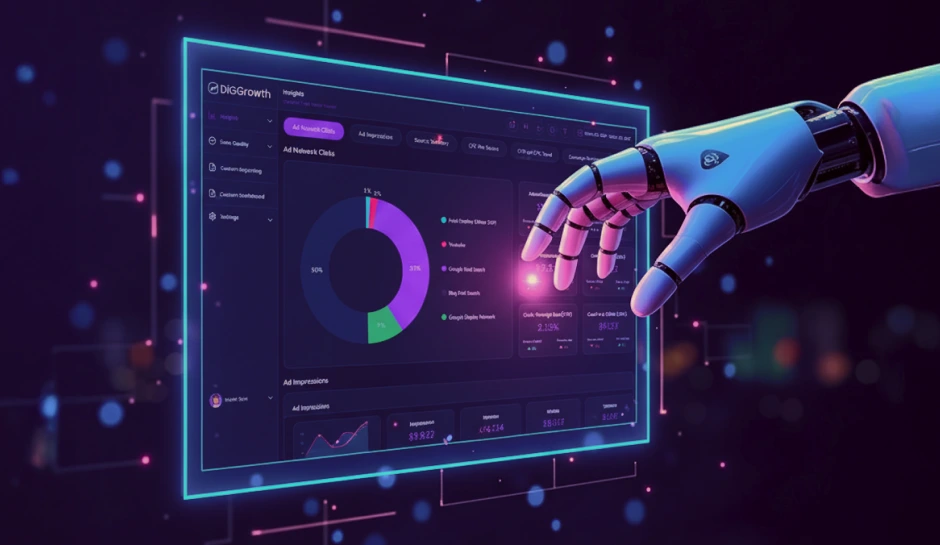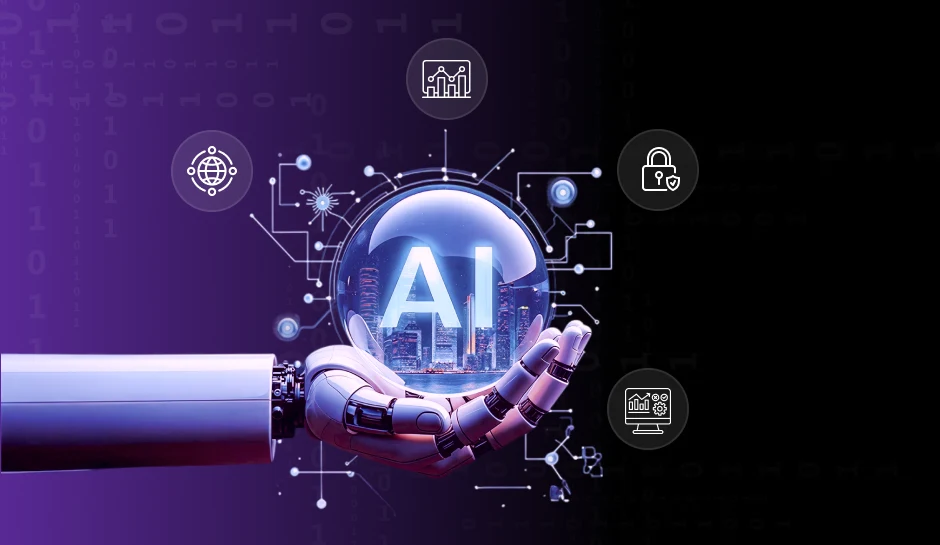In this episode of The Revenue-Focused Marketer, host Hershey speaks with Manas Talukdar, Director of Engineering at Labelbox, about the deep and evolving impact of AI across industries, from marketing and healthcare to defense and manufacturing.
They explore how AI is shifting from experimental hype to practical value, emphasizing the foundational role of data infrastructure, the rise of agentic AI, and the future of large language models (LLMs). Manas explains how companies can start with low-complexity AI projects to see real results, and why understanding the capabilities and limitations of AI is key to unlocking its true potential.
They also dive into timely topics like job displacement vs. job loss, the ethics of AI development, and the implications of open-source models like DeepSeek AI. Whether you’re a marketing leader, technologist, or strategist looking to future-proof your approach, this conversation is packed with practical guidance and thought-provoking insights.
By tuning in to this episode, you can expect to come away with an understanding of:
- How AI is more likely to displace jobs than eliminate them
- Why AI’s biggest breakthroughs often come from non-marketing industries like manufacturing
- How to identify realistic use cases and avoid AI project failure
- Why clean, unified data is the true foundation of successful AI
- What agentic AI means, and where it offers value vs. risk
- How LLMs are evolving toward domain-level expertise
- What DeepSeek AI represents in the open-source landscape
- Why ethical guardrails and data privacy policies are urgently needed
- Where AI innovation will happen next and who will have access
Featured Speakers:-

Manas Talukdar
Director of Engineering, LabelboxManas Talukdar is a senior leader in Enterprise AI and Data Infrastructure, with experience spanning both startups and global enterprises. He has led the development of large-scale AI and data products used around the world and made significant contributions to process data systems that power industrial innovation. Manas is a patent holder, mentor, and frequent speaker at AI and leadership conferences. His expertise bridges deep technical insight with practical leadership, helping businesses scale AI solutions responsibly and effectively.

Harshika Chadha
Lead Product Manager - DiGGrowthHarshika is a seasoned product manager with a passion for business transformation, design thinking, technology, marketing trends, SaaS security, and human-computer interactions. What interests her most is the intersection of these fields, which is why she stays on top of the latest industry insights to uncover strategies for success in today's dynamic business landscape.
More From Our Content Repertoire
- Data Governance Strategy: Building a Framework for Trust and Compliance
- Breaking Down Barriers: AI Tools and the Democratization of Data Analysis in B2B Marketing Why
- How To Become An AI-Ready Organization
Transcript
0:11:
Hello and welcome to another episode of the revenue-focused marketer where we discuss anything and everything related to marketing as well as data.
0:20:
, this is where we kind of really love to dig into latest trends, insights, innovation, and breakthrough ideas that are shaping the industry.
0:28:
I’m your usual host, Hershey, and today we have a very special guest with us, Manus, who is the director of engineering at Label Box.
0:36:
So thank you so much for joining us today.
0:39:
Thank you, Hershey.
0:40:
Happy to be here.
0:40:
Thank you for having me.
0:42:
Perfect.
0:42:
Just a little bit about him.
0:44:
He is a senior industry leader in enterprise AI in data infrastructure.
0:49:
He has a lot of leadership experience spanning startups as well as large companies, and he’s really been in the forefront of AI-driven transformations.
0:59:
So you know, we kind of.
1:00:
really dive into a hot topic here and kind of talk about how AI is driving change across industries and maybe we’ll even talk about, you know, how it’s impacting marketing, but I want to really start off by, you know, kind of giving and opening up the floor to you to just share your journey with our listeners here today.
1:20:
Sure, thanks, Hershi.
1:21:
So I’ve been in the industry for about a couple of decades now.
1:24:
I started my career working for an industrial software company here in the San Francisco Bay Area.
1:29:
I also worked on things like time series historians, Milware SDKs, the data and IT platforms for all for industrial AI use cases.
1:37:
Of course, no one cared about AI or industrial AI back in the day.
1:41:
It was broadly the domain of data infrastructure, data analytics.
1:46:
Then I joined the C3 AI, , arguably the leading enterprise AI company in the world, , while they were still a startup, , went through the journey of hitting IPOs, helping scale the company, the business, , had a really great time contributing to, as I said, the leading enterprise AI platform in the world.
2:07:
It was an excellent experience, worked with a lot of smart people.
2:11:
, then, , sometime a little over a year ago, I joined Label box.
2:15:
So label box, we are, we’re a Series D startup, based out of the San Francisco Bay Area here.
2:22:
So what we do is we help enterprises develop past specific custom models and that we also work with the AI labs.
2:29:
And then by AI labs, I mean the providers.
2:32:
We work with them and help them by giving them highly specialized training data, , specifically for the post-training phase.
2:40:
And you can think about, say, when I say highly specialized, you can think about training data in nuclear physics.
2:46:
Or cardiology or audio engineering, perhaps atmospheric science and so on and so forth.
2:53:
Mhm.
2:54:
That’s wonderful.
2:55:
Thank you so much for, you know, sharing that with us.
2:58:
I think to kind of start off, I’d love to kind of, you know, get your thoughts on how do you think, you know, you’ve kind of mentioned you’ve been working in AI before people even thought it was cool.
3:09:
It wasn’t a buzzword, it wasn’t what everybody was talking about.
3:13:
So how do you think AI has kind of revolutionized over the years and you know, how do you kind of see industries being impacted across the board from like healthcare to finance to marketing as well as manufacturing and like you know just want to get your perspective on how like it’s being reshaped today.
3:35:
So I think the biggest impact in my opinion or the longest impact probably AI has had in the industrial world probably has been in manufacturing.
3:45:
So, , you know, predictive analytics has been around in manufacturing since a very long time and like you alluded to and like I mentioned, even before people are calling it AI.
3:56:
, so, so, you know, whether it’s in pharmaceutical, whether it’s in, , oil and gas, predictive analytics has been a big deal for a very long time.
4:06:
Now, obviously, since the last 4 or 5 years that has been formalized and people actually call it AI in the sense that, hey, we’ll use AI to be able to predict failure rates of our equipment to be able to predict things like demand generation and so on and so forth.
4:23:
Now that’s one aspect of it.
4:25:
Other aspects are CAI is also being used in supply chain optimization.
4:30:
It’s also being used in the pharmaceutical sector for batch prediction things and then also for in the for manufacturing of pharmaceutical equipment as well.
4:41:
, 11 of the biggest products that that’s out there that in my previous company Cr built out.
4:48:
The reliability AI product, it’s basically an industry leader, and it’s used all over the place from oil and gas sector to manufacturing, primarily for doing predictive analytics, but it’s, it’s positioned as AI prediction tool, which is rightfully so.
5:08:
, other use cases I can give you say, you know, one I really love to talk about is A very big oil and gas company, they use AI to be able to predict rust rates of the pipelines in their massive refineries.
5:22:
So you’ll have drones flying around this huge humongous refinery taking pictures of their pipelines, and then there’s post processing of these pictures that happened with AI, and it helps to predict rustrates and then predict when to fix these pipelines, you know, when something might fail before the failure actually happens, which might lead to losses of tens of millions of dollars.
5:43:
Other use cases are even in the defense sector, for example, you know, a particular country is using AI to increase the operational readiness of their aircraft fleet, and aircraft fleets, not just any aircraft aircraft fleets, you know, they’re really the 5th generation aircraft fleet, so you can probably imagine what country this is and which aircraft aircraft fleet it is.
6:05:
Then other use cases of AI that’s really picking up more recently, you know, is in state and local domain.
6:12:
Where law enforcement is starting to look into it, of course, that can be controversial sometimes.
6:18:
, AI is also being used in property appraisal in the real estate market.
6:23:
, now, there have been some missteps in the real estate market with AI.
6:27:
I remember 3 years or 2 years back, I think Zillow wanted to use AI to really increase the profits, really flip houses, and that was a massive failure for reasons we don’t have to get into now.
6:40:
But more recently, AI is certainly being used for things like property appraisal in the real sector.
6:46:
, in the financial, you mentioned financial sector, financial sector, I think SWIFT is a big consumer of AI for fraud detection, and SWIFT is basically, you know, the backbone of the financial industry.
6:58:
Anytime a credit card transaction happens, 90% probability, perhaps even more, that it goes to the SWIFT transaction engine.
7:06:
, and then several banks are also using AI in the financial sector for personalized recommendations.
7:12:
Now, in the marketing world, you know, AI is being used again for personalized recommendation for demand generation.
7:19:
And they’re also being able to predict the outcome of certain campaigns, you know, based on a lot of signals that’s been gleaned off of social media.
7:28:
Yeah.
7:29:
No, I think you summarized that pretty well.
7:31:
Like every aspect of our lives today and each and every industry has different use cases of AI how AI is being implemented, but it is something that is kind of touching each and every industry, kind of talking.
7:44:
about the marketing side.
7:46:
I know within our company also growth, predictive lead scoring for like the leads that come that kind of want to be converted and sales teams need to focus on.
7:55:
That’s something that we we’ve been putting a lot of our efforts into also.
8:00:
So I know like you know if we went back and did it manually to now what we see in the predictiveness from AI, there’s a huge difference.
8:10:
And I think what I’m trying to understand here still is like, you know, there are still people that are still on the sort of fence about using AI.
8:21:
They could be smaller enterprises or even like, you know, CMOs that I’ve kind of chatted with that are still hesitant to kind of use AI.
8:30:
So what advice would you have for people that are, you know, still just getting there, dipping their feet into this sort of AI water and how can they go about it?
8:40:
So the important thing to think about is to have a very clear business use case for implementing an AI project,#1.
8:48:
#2, not to get over ambitious and come up with some overarching, you know, directions and, OK, let’s implement AI in our company, which really means nothing in my opinion.
8:59:
So a very clear business use case come out with a very low complexity problem.
9:04:
, and, and figure out what’s the low hanging fruit where AI can be used.
9:09:
Now really the way to think about it is three aspects, you know, in the traditional AI machine learning world and I should say, quote unquote traditional, there is the aspect of predicting of classifying, and then more recently we generative AI is generation.
9:26:
So I would recommend the CMOs or or or executives and marketing or other places to think about.
9:33:
Which of these three categories the low complexity, low hanging fruit, business use case would fall under and then go from there.
9:41:
And I have seen many projects in my time in the industry where, you know, there’s some overarching driver from somebody at the top of the ladder, somebody from the executive team who might say, yeah, let’s use AI, which again, which was nothing, and somebody will go and come up with some really complex plot project, and that’s just a recipe for failure.
10:00:
, another very important point to think about is that there’s no AI without data, and by data, I mean some things to think about is data infrastructure.
10:09:
, by data infrastructure, what I mean is data in to the data inition pipelines exist?
10:14:
What is the quality of the data?
10:16:
What kind of transformations may have to be done?
10:18:
How would these data pipelines integrate with machine learning pipelines?
10:23:
So there’s a lot of things that need to be carefully considered, you know, when thinking about how to go about implementing AI in a business, but one, if I were to give one takeaway, always think about a low complexity project to begin with.
10:37:
No, that’s definitely helpful.
10:39:
I think when you kind of mention about data being the backbone of it, I think that’s such an important piece that people do end up missing out on.
10:47:
We like to always say within our company garbage in is garbage out.
10:51:
So you know, if you’re not really working on unifying that data, making sure that the quality of data is good, you’re not able to really get the insights that you need.
11:01:
, we joke if like, you know, if you’re kind of using AI with the company and you’re not able to get the right answer.
11:07:
It’s not the GPT’s fault or like, you know, the AI that you’re using, you’re the one that’s not asking the right questions.
11:14:
So I think it’s like, you know, a lot of work is.
11:18:
done into kind of reshaping this approach, but I wanted to understand from you, like, you know, AI is evolving at a pretty rapid pace, but what do you think are some of the, you know, bigger challenges that still need to be solved for AI to reach kind of its full potential?
11:36:
Well, I mean, that’s a fairly open-ended question.
11:39:
I mean there’s still a little bit.
11:41:
There’s a lot of hype going on in the industry right now about AGI.
11:46:
Now, I think a lot of it is rightfully so hype.
11:50:
Now EGI in my mind means , sentience through AGI, I mean, for whatever it’s worth, in my opinion, it’s sentience.
11:58:
How close are we to sentience?
12:00:
I don’t think we are even remotely close right now.
12:03:
It’s very probabilistic, which is not a bad thing, you know, a lot of human behavior is also probabilistic, but , Tru sentience, we are very far away from that.
12:13:
Now that said, AI as it currently exists with LLMs and perhaps other architectures that that’s currently on the research.
12:20:
We can still achieve a lot in terms of automation, in terms of workflow automation.
12:25:
We can still achieve a lot in terms of augmenting various fields of human endeavor.
12:30:
You know, one thing, 11 field which obviously is very closely related to my domain of work is in software engineering.
12:37:
And we are seeing a lot of development in LLMs which is actually enabling software engineers to do a lot more in less time by using various AI tools.
12:46:
And similar developments can also be availed of in other domains, even in marketing, for example, whether it’s for demand generation, for lead prediction, whether it’s for AI augmented CRM software.
12:58:
So a lot of the things are happening, but in order to really leverage it, people need to understand how to use it, how to.
13:05:
Use prompts, people also need to be able to sift, you know, the, the right tools from the hype out there.
13:13:
Definitely.
13:15:
I think another aspect that is kind of like, you know, in hype right now is kind of agentic AI and sort of the growing area of discussion.
13:25:
So I kind of wanted to get your thoughts on this.
13:27:
Where can AI act more independently with minimal human intervention and what do you maybe see as the risks and, you know, the opportunities of having more work done in that space?
13:41:
Right.
13:42:
Well, for, you know, risk is a very important word.
13:44:
Therefore, risk elimination, you know, any AI endeavor, ideally it should be potent and potency should not result in Any sort of risk or or.
14:00:
, any bad outcome for human society.
14:05:
So now as you mentioned agent TI, you know, agent TI, the way I think about it is, you know, a small, , A quote unquote agent, that’s when when I say agent, I mean a small step in a particular workflow that’s being automated using either a machine learning model, a smaller machine learning model, or a large LLM.
14:25:
So in a way it’s not too unlike how you know you would think about microservices back in the day where each microservice is supposed to do one task and one task very well.
14:35:
So each AI agent, the way I think about it, is supposed to do one small task and should do that one small task very well.
14:42:
So I think workflow automation is a big domain for agent AI where you can have one agent do one task in a particular large workflow and it does that really well with high reliability and then you have a bunch of these agents doing a bunch of complex workflows, but that is definitely a big domain where we can use agent AI.
15:04:
, in the industrial world, obviously it can be a huge application, but again in the industrial world, the, the margin of error is very low.
15:13:
You know, we are talking about like maybe, , if, if there is even one micro 1 nanometer, , different in tolerance for a particular component that is manufactured, that can have catastrophic outcomes.
15:28:
So we are a little bit, a little bit away from implementation of aging AI in the industrial world, but definitely for things like, , you know, relevant to your listeners perhaps marketing campaign automations, you know, defining as a workflow, agent AI certainly has a lot of applications.
15:46:
Definitely.
15:47:
I think that makes a lot of sense and I think in the near future, we can definitely see more automation being done in that space.
15:55:
, this is one of the fun questions to ask, I guess, that I like to kind of learn, you know, from my list, , guest speakers, but I just wanted to understand your thoughts on is AI, you know, here to stay and is it taking away jobs?
16:12:
Like, you know, are humans going to be losing jobs or is that something that can coexist and like, you know, like jobs are still good.
16:20:
I just want to get your thoughts on that aspect.
16:24:
Well, AI will certainly have a definitive impact on the world economy.
16:29:
Is it going to Lead to elimination of jobs in certain domains, yes, but more so on the way I think about it, it, it will lead to job displacement.
16:40:
Not job elimination necessarily, and the workforce, the workforce of the world will have to be retrained, will have to be re-skilled to be able to learn how they can use AI to become more productive in their jobs.
16:54:
So in any domain, you know, people who are able to use AI to drive their productivity, they will actually do better.
17:01:
So I don’t think people should be afraid about job elimination, and some of it will happen for sure, but mostly it’s going to be job displacement.
17:08:
And the changing nature of work where a lot of automation will happen because of AI and then individuals, human beings who are working in various domains right now, they’ll have to work with AI to be more productive in their jobs.
17:22:
That makes sense.
17:24:
I think another recent or I guess it’s been a bit for this, but Deep Seek AI, , you know, has been seeking a lot of traction, especially on LinkedIn, a lot of discussions, debates over like, you know, is it just a copy of OpenAI or is it.
17:40:
Like, you know, something that is at a cheaper cost and it’s going to make an impact.
17:46:
So have you, you know, had any thoughts about it?
17:49:
Have you explored the tool at all and, you know, how do you see it comparing to other popular AI models in the space and yeah, just.
17:59:
Yeah, so definitely, you know, kind of ruffles the feathers in certain companies for sure in a lot of American AI companies.
18:08:
So to speak.
18:09:
Now, , I think DeepSI did implement a lot of some innovations, key innovations in their post-training phase.
18:17:
Now, and there was a lot of hype about he, they just did it in 6 million.
18:21:
That’s not true at all.
18:22:
Even in their paper, they very categorically mentioned that 6 million was mostly in the post-training phase.
18:28:
So they did, they did a lot of optimizations and innovations and really kudos to them.
18:33:
But the what I call the baseline training phase, that definitely took a lot more significantly more than 6 million.
18:41:
Now, , they were able to do optimizations because of these innovations and I’m sure some of the optimizations happened because of the low cost of labor data in China compared to the West.
18:52:
Furthermore, there was model distillation undoubtedly, which is why in a lot of Chinese models and perhaps even including deep deep see, sometimes they would mis misidentify as some of their model.
19:04:
So model distillation happened and which is also why a lot of American companies, AI companies, they have started to, and they have already blocked their training traces from becoming public.
19:15:
So because of all these reasons, you know, sometimes these models would misidentified, the Chinese models would misidentify as some other model because of model distillation.
19:24:
But I think undeniably Deepick did implement some innovations in the way they went about in the post training phase, and I don’t remember the exact detail, but what I do remember is they implemented something.
19:36:
Which is where in an iterative training process, you would use the learning from the previous step, you know, kind of, you think about it as a machine learning technique or transfer learning.
19:44:
It’s not transfer learning, but conceptually it’s similar.
19:49:
That makes sense, right.
19:51:
I think for a lot of people while using, you know, deep seek, another concern kind of comes back to the ethics and also how the data is being used and how much, you know, is being shared even with governments being involved.
20:06:
So what are your thoughts on, you know, sort of the ethical considerations that come with the eye, because these are two things that kind of have to go hand in hand, but I’m not sure how much work is already being done to kind of, you know, improve that.
20:21:
So I mean, going back to Deepse, , the good thing is that now a high quality reasoning model is available for free to anyone.
20:30:
And of course since it’s open source, it can be hosted anywhere.
20:33:
So and it’s already happened.
20:35:
American AI infrastructure companies have already hosted DeepSeek and they’re offering it as their part of their model serving platform.
20:43:
, so it doesn’t mean because it’s a Chinese model, it’s only hosted in China.
20:49:
Yes, it is hosted in China, but also hosted in other places, so that’s good.
20:53:
Now going back to ethical concerns, I think what’s important is that you know when training models, there needs to be some sort of guards around privacy, perhaps using anonymization of personally identifiable information, perhaps using differential privacy techniques.
21:13:
, then, , there also needs to be some policy, , things in my opinion, like, for example, , in, in, in social media world, a lot of companies, they’re not necessarily accountable for what’s out there, you know, they, they present themselves as we are merely the medium.
21:32:
And so I think we need to think long and hard about how that accountability factor is going to play out in the AI world.
21:40:
And then I think there also needs to be something along the lines of the right to be forgotten, which has been implemented for search engines.
21:48:
Similarly, consumers need to be protected with the right to be forgotten, right to be forgotten from inferences of LLMs as well as from trading data.
21:56:
So these things haven’t happened yet, but there are some conversations happening.
22:01:
At the industry level, at the at the policy level with lawmakers, so I’m hopeful that in the foreseeable future some, if not all of these things will definitely see the light of the day.
22:12:
Wonderful.
22:13:
Yeah, I think that’s definitely something that needs to be looked upon, especially now that, you know, it has become the hype.
22:21:
It is something that is being touched by each and every industry.
22:26:
Some form of regulation is definitely required in this area, and policies can be one of the measures of going about this for sure.
22:34:
, I know we’re kind of coming to the end of our session here today, but I did want to ask you one last question that kind of focuses on, like, you know, the future that is to come now.
22:44:
So looking ahead, what trends in AI do you believe will define the next 5 to 10 years?
22:51:
Well, right now there is a trend, there is a move in the industry to get LLMs to, to say, PhD or professor level expertise in various domains.
23:03:
So I think what’s going to happen is probably within the next 1 or 2 years we’ll have a lot of LLMs get the professor level expertise in various domains like say computer science or nuclear physics, astrophysics, you know, and a lot of these fields.
23:20:
So what that means is, does that mean We will not need universities doing research, not at all.
23:29:
That that will absolutely still exist.
23:31:
, but you know, LLMs are gaining more and more high quality training data, and that’s reflecting in the quality of the responses.
23:40:
That’s reflecting in how expert they are getting in these fields.
23:45:
I think the monetization of this is yet to be figured out.
23:47:
I just saw a news item yesterday that OpenAI is apparently planning to monetize a professor level AI agent, you know, at $20,000 per month.
23:59:
Now, I, you know, we’ll have to see how successful that is because as we all know, you know, grad school, grad students, PhD students are probably very underfunded, so we, it remains to be seen how, you know, if somebody would be willing to pay that kind of money.
24:16:
, so in the next 12 years, definitely this trend in the industry of LLMs getting to professor level expertise in these domains, it will not only continue, it will actually come to fruition in my opinion.
24:28:
And then there’s other things happening in terms of other architectures.
24:33:
, it hasn’t gained traction yet, but, you know, in one of the most reputable, , machine learning conferences last year it was the end of last year, new reps.
24:42:
Definitely there was some discussion about other architectures beyond LLM, so that trend will also continue.
24:49:
And then I think we’ll just see.
24:52:
Perhaps we’ll see some more innovations in terms of how optimizations can be done in the post training phase, similarly to what GSI did in terms of how to not spend too much money on GPUs.
25:08:
And then one other thing I would like to see personally, and I don’t know what’s going on there, not much actually, where Optimizing, , training of LLMs, particularly in the baseline training phase, which is where we incur most amount of money.
25:25:
, such that we don’t have to, somebody doesn’t have to spend like hundreds of millions to be able to spin off a high quality.
25:32:
Like for example, for Grok 3, I heard that Elon Musk had to spend probably around $20 billion spinning up data centers, buying GPUs and whatnot.
25:44:
So right now it’s unfortunate that in order to really create a high quality LLM.
25:49:
You know, you know, you need only people with deep pockets.
25:52:
So I’m hoping there’s some innovation there in terms of chip design, in terms of the baseline training phase where there’s more accessibility and, , you know, to the players who can actually create these LMs instead of just a few big players with big pockets.
26:08:
Yeah, that definitely makes sense.
26:11:
Wow, this has been such an incredibly insightful discussion, and it’s clear that, you know, AI is really changing the way we work, the way we think, the way we innovate, and it’s touching each and every industry that we kind of talked about in this session.
26:27:
So before we wrap up today, for people that kind of you know, want to learn more from you, more about you and your company, how can they kind of reach out to you?
26:37:
, they can connect with me on LinkedIn or I have a website.
26:41:
It’s my first name, last name.github.io, you know, that’s, as I like to put it, that’s the entry point, that’s linked up to all my other social media profiles on LinkedIn, on Twitter, on X, that is.
26:53:
So my website is the best place to start reaching out to me, or, or I’m also open to connections on LinkedIn.
27:00:
Wonderful.
27:01:
Thank you so much again for joining us today and for those listening, if you’d like to, you know, stay updated on AI’s latest advancements and also learn about what’s happening in the sort of marketing industry, be sure to, you know, connect with us, stay in touch, do share, you know, your thoughts on this episode.
27:18:
And as always, like, you know, if you did enjoy this episode, do see us at our next one.
27:24:
Thank you so much and have a great one ahead.
27:27:
Thank you again, Manus, for joining us.




